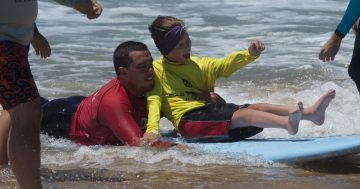
A couple of beachgoers head into the surf at Werri Beach, south of Kiama. Photo: Destination NSW.
Has your Christmas gift lit a fire in you to become the next Carissa Moore or Kelly Slater?
Whether it’s a slick shortboard, an 11-ft log or a stand-up paddleboard, before you take to the water with your new craft it’s important to learn the etiquette.
Not just for if you have an audience with the King – in the water etiquette will help keep you safe, and hopefully make you some new friends.
Region asked Tristan Gale, from the Pines Surf Academy, about his top tips for new surfers.
Before you even paddle out, he said you need to know your limits, and where to go.
“The ocean can change quickly, and that can be dangerous if you don’t know your level,” he said.
“Not just for you, but people who come to help you put their lives at risk.”
So, do a quick search online, and pick a beach that’s known for calm, safe conditions – not Aussie Pipe.
Once you get to the beach, you might be tempted to paddle out between the flags if you’re not confident, or to paddle out to all the other surfers.
Neither is a good option for learners, not least because surfboards are banned between the flags.
“It’s like learning to drive a car – you don’t want to start on a busy freeway,” Tristan said.
“You want somewhere a bit quieter to practise.”
The bigger your craft, the greater the potential to hurt anyone you collide with, and the more space you’ll want to practise safely.
You’ve picked your spot, and as you’re paddling out, a surfer on a wave comes zooming towards you. What now?
Like driving a car, someone has right of way in every situation. In this instance, the person on the wave takes priority – so best move out of their way as quickly as possible.
“It’s not their responsibility to avoid you, and if they’re learning too they might not have the skills to do that,” Tristan said.
“It can be hard to know where to paddle when you’re a novice, but it’s really important to show some urgency in getting out of the way.
“Surfboards are hard and pointy. If there’s a collision, one or both of you could be seriously hurt.”
When you go to catch a wave of your own, right of way still applies.
If you’ve progressed to catching unbroken waves, the person closest to the peak – the point of the wave that breaks first – has right of way.
If you’re still in the whitewash, a good rule of thumb is to never go for a wave that already has somebody on it.
“When you’re at a roundabout you have to give way to the people inside of you, or already on the roundabout,” Tristan said.
“If you pull out in front of someone you’re probably going to get a beep, or cause a crash.
“If you drop in on someone you’re probably going to get a telling off, and you could cause an accident.”
You’ve picked your beach, found your spot, paddled out safely, respected the lineup, and got your first wave.
Life’s good! Now what?
Well, as tempting as it is, don’t go straight back out and take another one.
While you were catching your wave, other people were waiting patiently. Give them a go.
“It’s a sharing thing, you don’t paddle inside of someone who has been waiting,” Tristan said.
“Share it around. Some people think everyone’s there to watch them surf, but really we all want to get our own wave.”
If you show good surf etiquette you’re more likely to make friends, and score some free tips.
And you could have a new hobby for life.
“Everybody should try surfing,” Tristan said.
“It’s beautiful, it’s good for your physical and mental health, and a great way to meet people.
“You can go to a party and a 12-year-old hotshot and a 70-year-old longboarder will connect over surfing – that’s pretty special.
“I remember when I was young it was a lot heavier than it is now.
“People are out there encouraging each other, giving advice; we see a lot of good.”


















